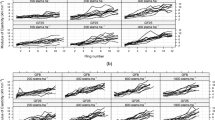Abstract
Thinnings from a 15-year-old eastern black walnut (Juglans nigra L.) agroforestry plantation in SW Missouri (USA) were evaluated to determine the influence of cropping practices on wood quality. Growth rate was found to be strongly affected by weed control and cropping practices while specific gravity and fiber length (measured in selected stems) were found to be weakly affected. of Missouri's Agricutural Experiment Station Journal Series.
Similar content being viewed by others
References
Berlyn GP and Miksche JP (1976) Botanical Microtechnique and Cytochemistry. The Iowa State University Press, 326 pp
Cutter BE (1991) Tree and wood quality in 15-year-old eastern black walnut (Juglans nigra L.) grown in agroforestry regimes. In: Garrett HE, ed, Proc of the 2nd Conference on Agroforestry in North America, pp 116–123. Springfield, Missouri
Garrett HE and Kurtz WB (1982) Nut production — a valuable asset in black walnut production. In: Black Walnut for the Future. USDA Forest Serv Gen Tech Rpt NC-74
Garrett HE and Kurtz WB (1983) Silvicultural and economic relationships of integrated forestry-farming with black walnut. Agroforestry Systems 1: 245–256
Garrett HE and Kurtz WB (1987) Nut production and its importance in black walnut management. In: 78th Annual Report of the Northern Nut Grower's Association, pp 23–28
Garrett HE, Jones JE, Kurtz WB and Slusher JP (1991) Black walnut (Juglans nigra L.) agroforestry — its design and potential as a land-use alternatiave. For Chron 67 (3): 213–218
Hiller, CH, Freese F and Smith DM (1972)Relationships in black walnut heartwood between color and other physical and anatomical characteristics. Wood Fiber 4: 38–42
Jones JE, Garrett, HE and Haines JK (1990) Production, harvesting, utilization, and marketing of eastern black walnut nuts — an industrial viewpoint. In: Proceedings of the Black Walnut Symposium, Carbondale, Illinois, pp 242–247
Kurtz WB, Garrett HE and Kincaid WH Jr (1984) Investment alternatives for black walnut plantation management. J For 82: 604–608
Lee CH (1986) A note on the effects of alcohol-benzene extractives on juvenile wood specific gravity in red pine. Wood Fiber Sci 18: 376–381
Miller RB (1976) Wood anatomy and identification of species of Juglans. Botan Gaz 137 (4): 368–377
Nelson ND, Maeglin RR and Daniels DH (1972) Relationship of black walnut wood color to soil properties and site. Wood Fiber 1: 29–37.
Panshin AJ and DeZeeuw C (1980) Textbook of Wood Technology, Vol I. McGraw-Hill, New York, 722 pp
Paul BH (1943) Black walnut for gunstocks. Southern Lumberman, April 15, 1943
Phelps JE and Chen PYS (1989) Lumber and wood properties of plantation-grown and naturally grown black walnut. For Prod J 39 (2): 58–60
Rink G (1987) Heartwood color and quantity variation in a young black walnut progeny test. Wood Fiber Sci 19: 93–100
Rink G and Phelps JE (1989) Variation in heartwood and sapwood properties among 10-year-old black walnut trees. Wood Fiber Sci 21: 177–182
Schlesinger RC and Van Sambeck JW (1986) Ground cover management can revitalize black walnut trees. N J Appl For 3: 49–51
Smith DM (1954) Maximum moisture content method for determining specific gravity of small wood samples. USDA For Serv Forest Products Laboratory Report No 2014, 8 pp
Szopa PS, Garrett HE and McGinnes EA Jr (1980) Growth-quality evaluation of black walnut wood. Part I — Specific gravity, growth rate and percent extractables for trees grown on three different sites in Missouri. Wood Sci 13: 95–98
Author information
Authors and Affiliations
Additional information
Research supported by McIntire-Stennis funds. This is Paper No. 11,859 in the University of Missouri's Agricutural Experiment Station Journal Series.
Rights and permissions
About this article
Cite this article
Cutter, B.E., Garrett, H.E. Wood quality in alleycropped eastern black walnut. Agroforest Syst 22, 25–32 (1993). https://doi.org/10.1007/BF00707467
Issue Date:
DOI: https://doi.org/10.1007/BF00707467




